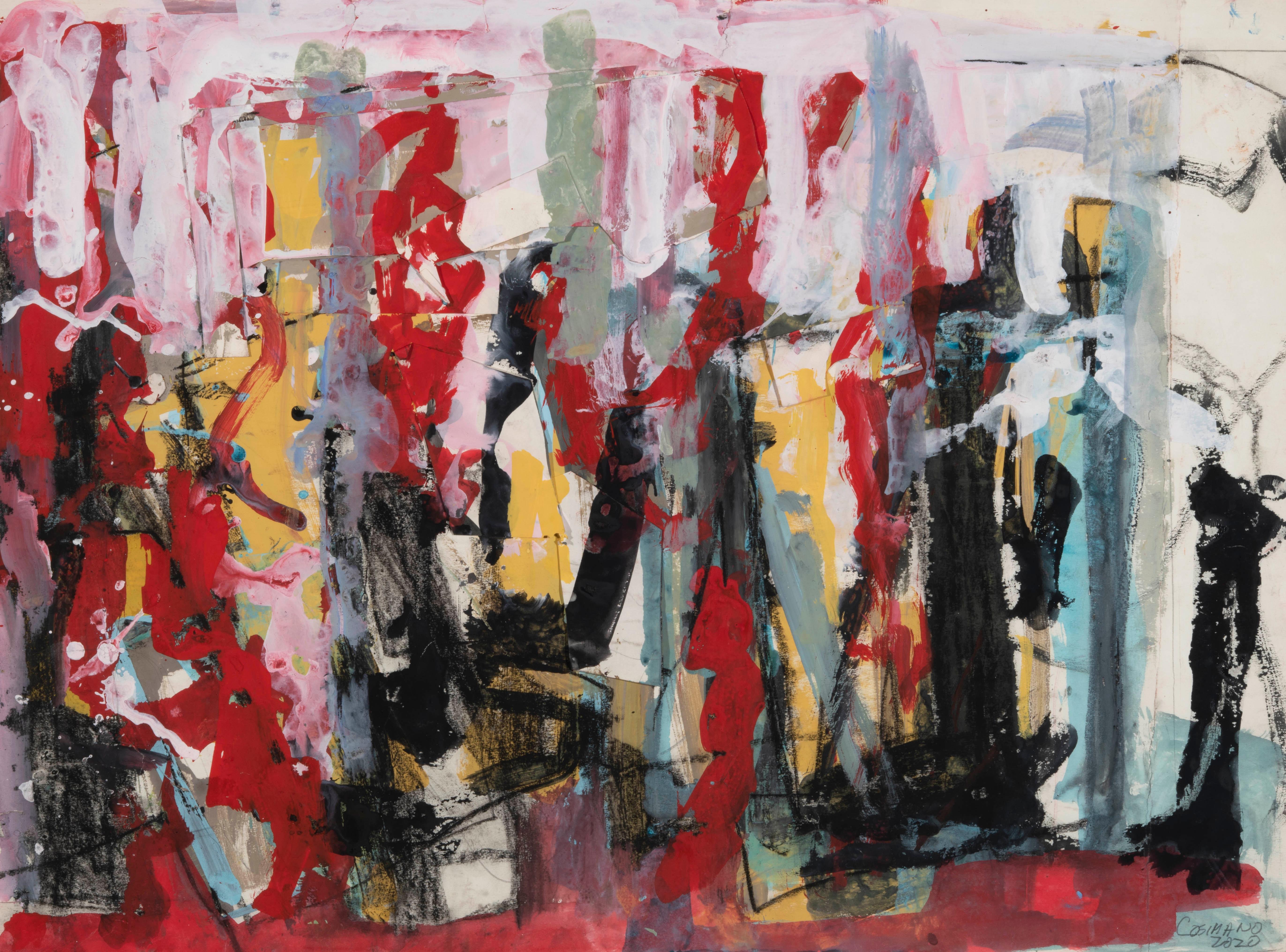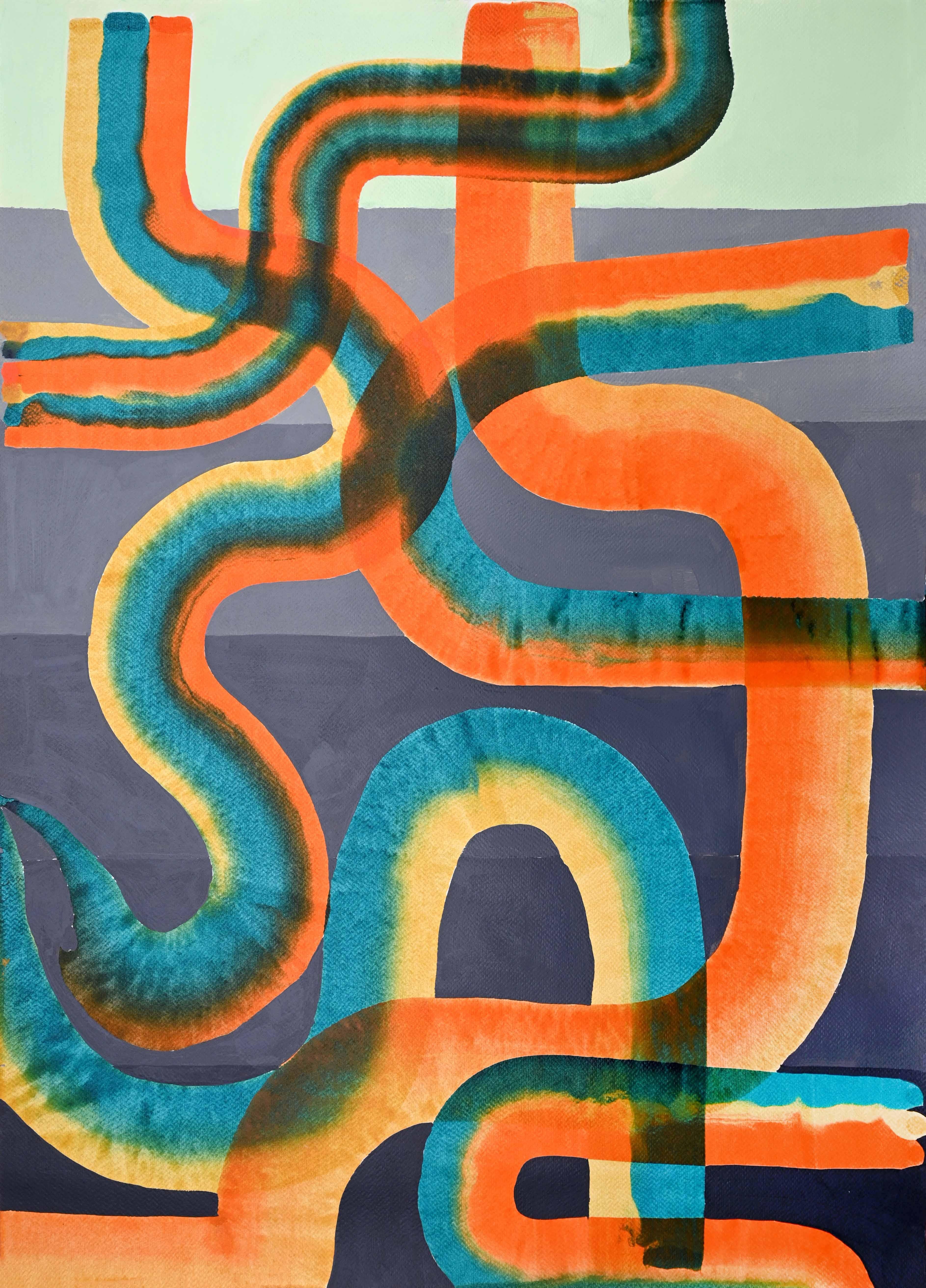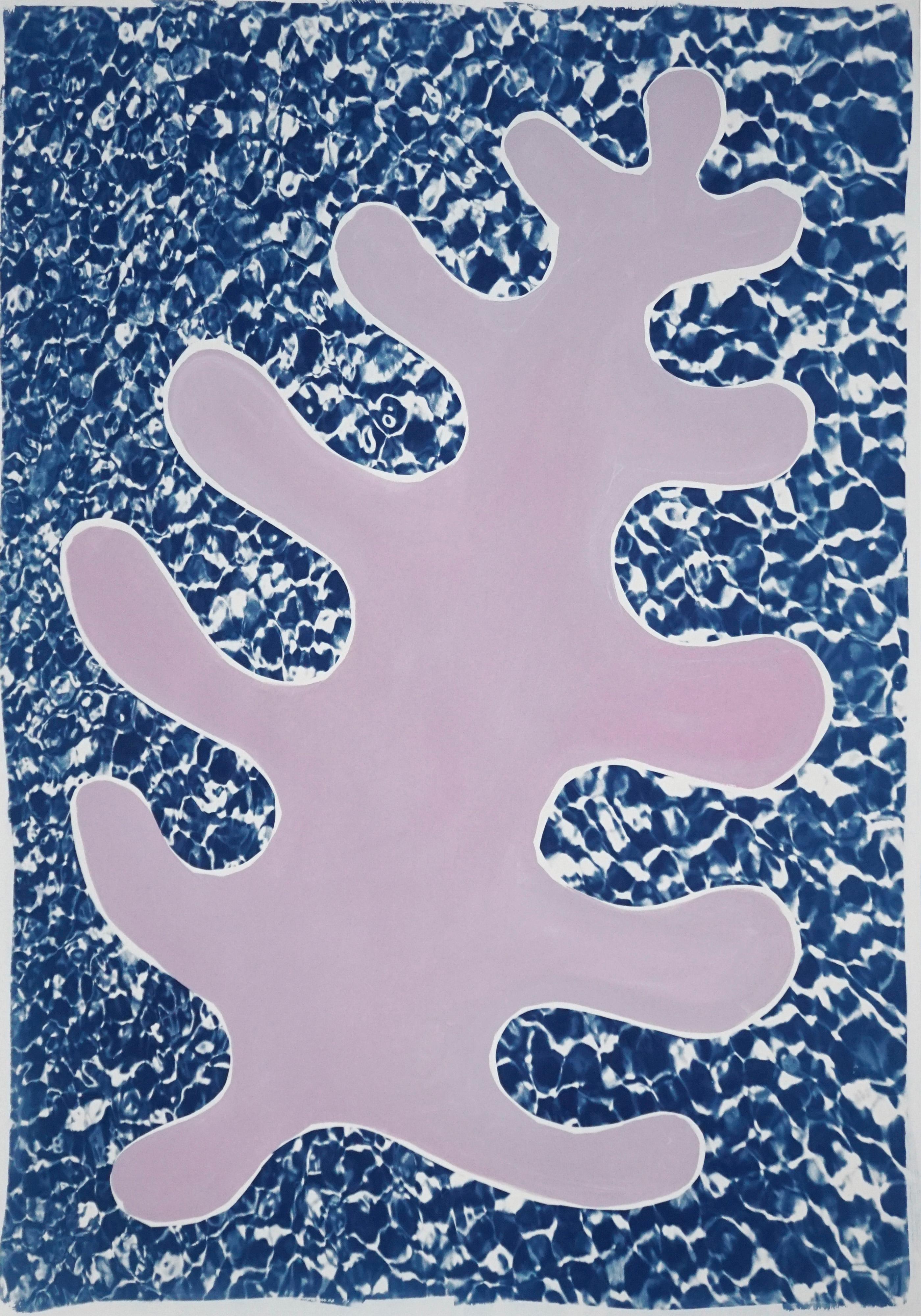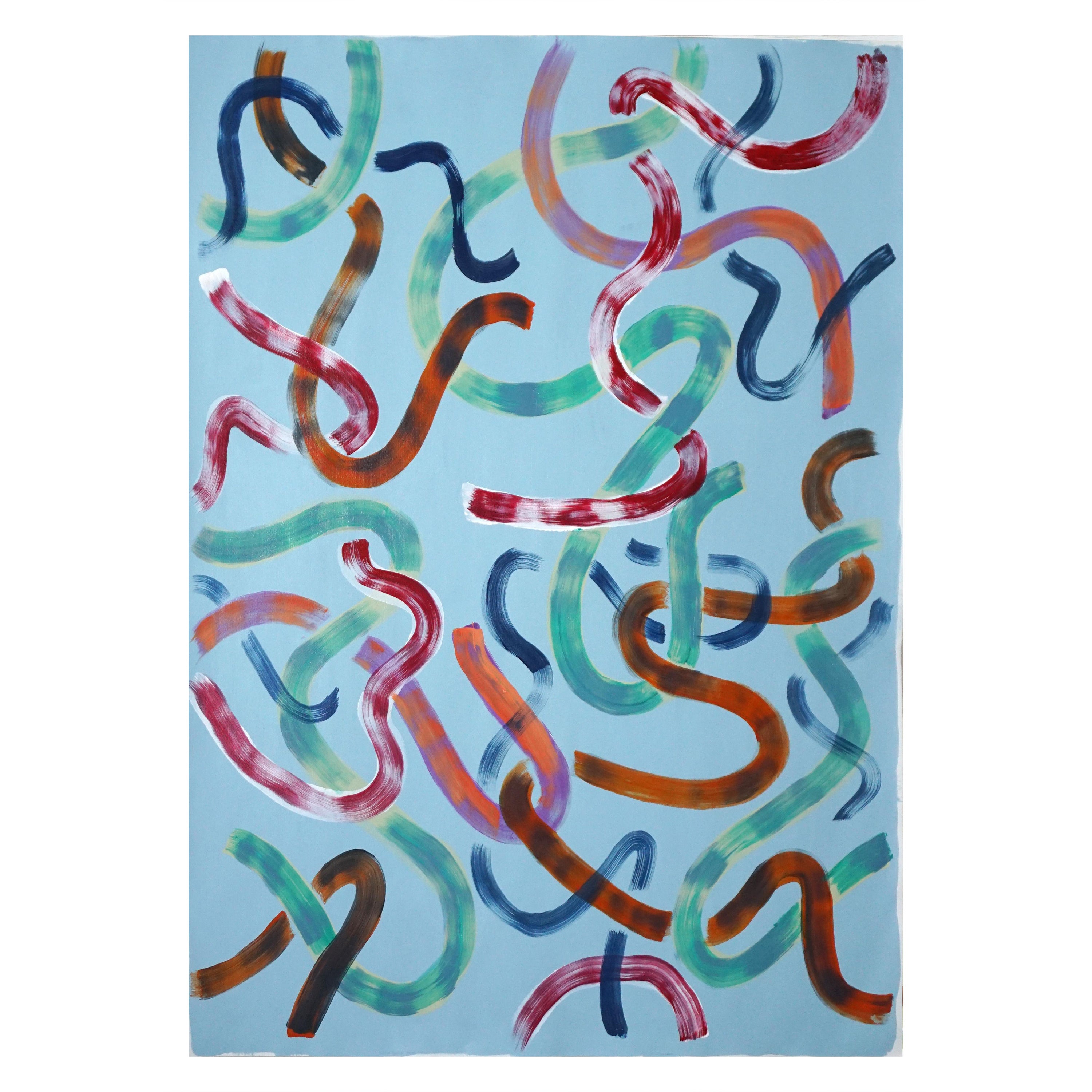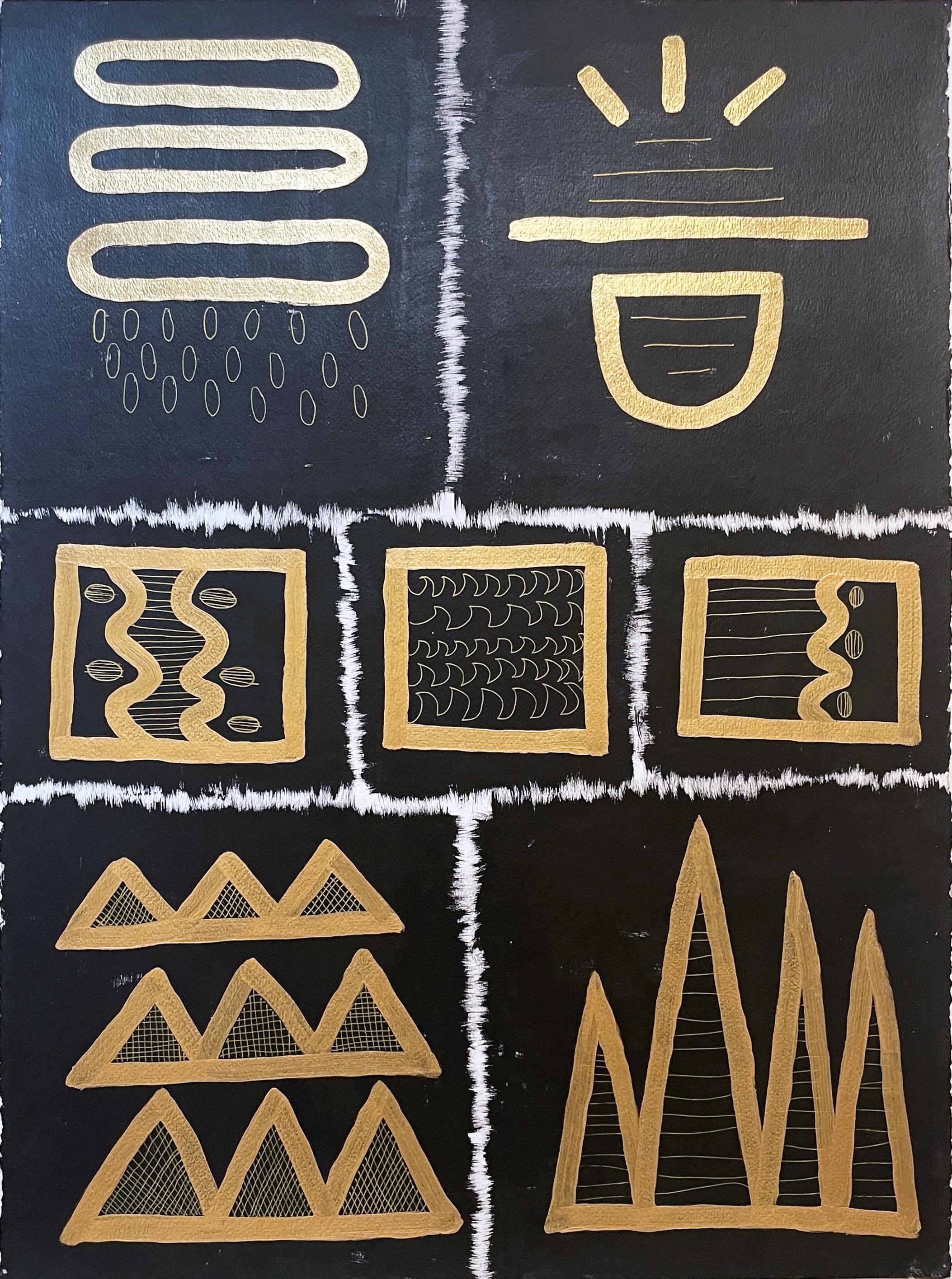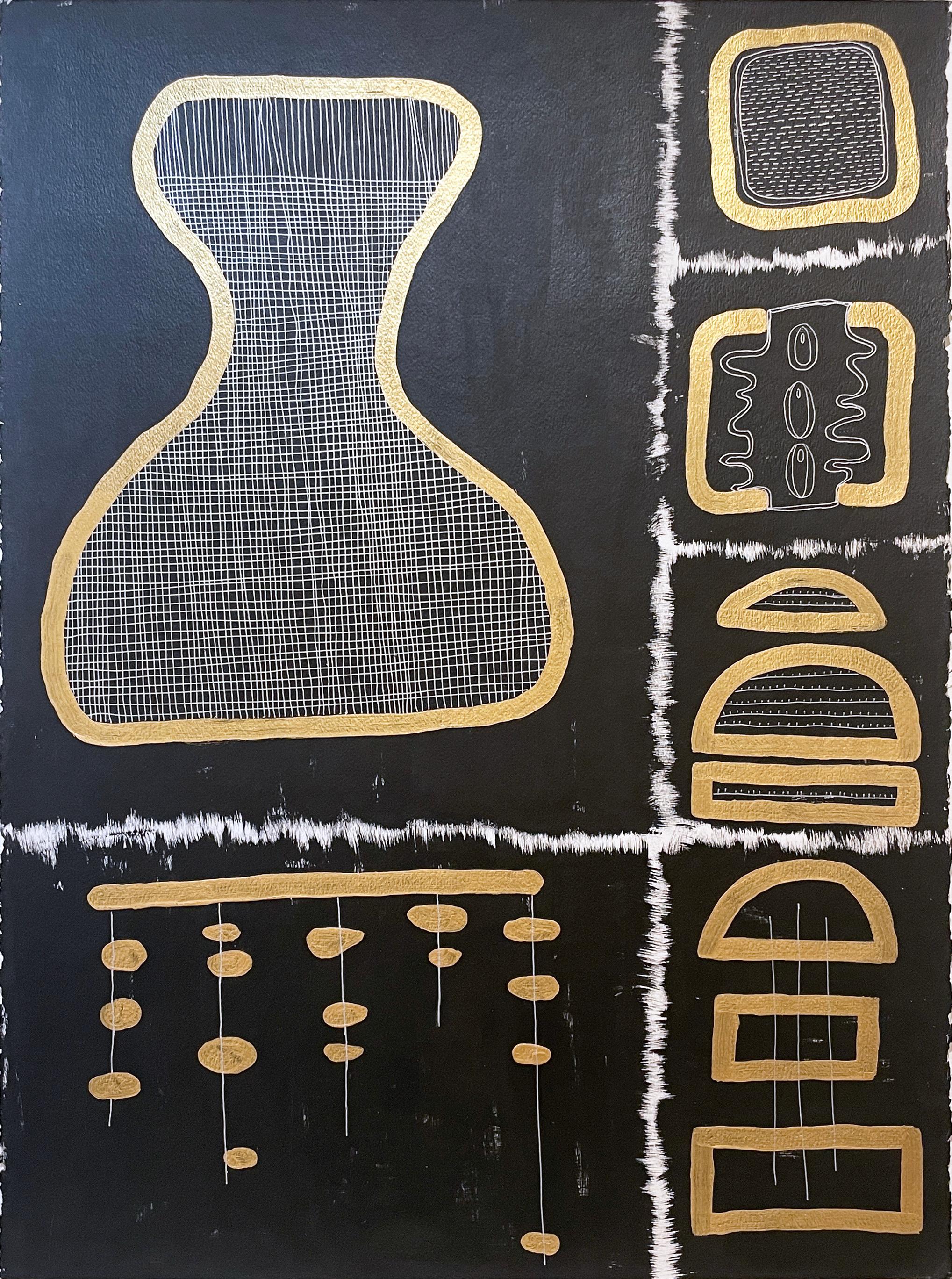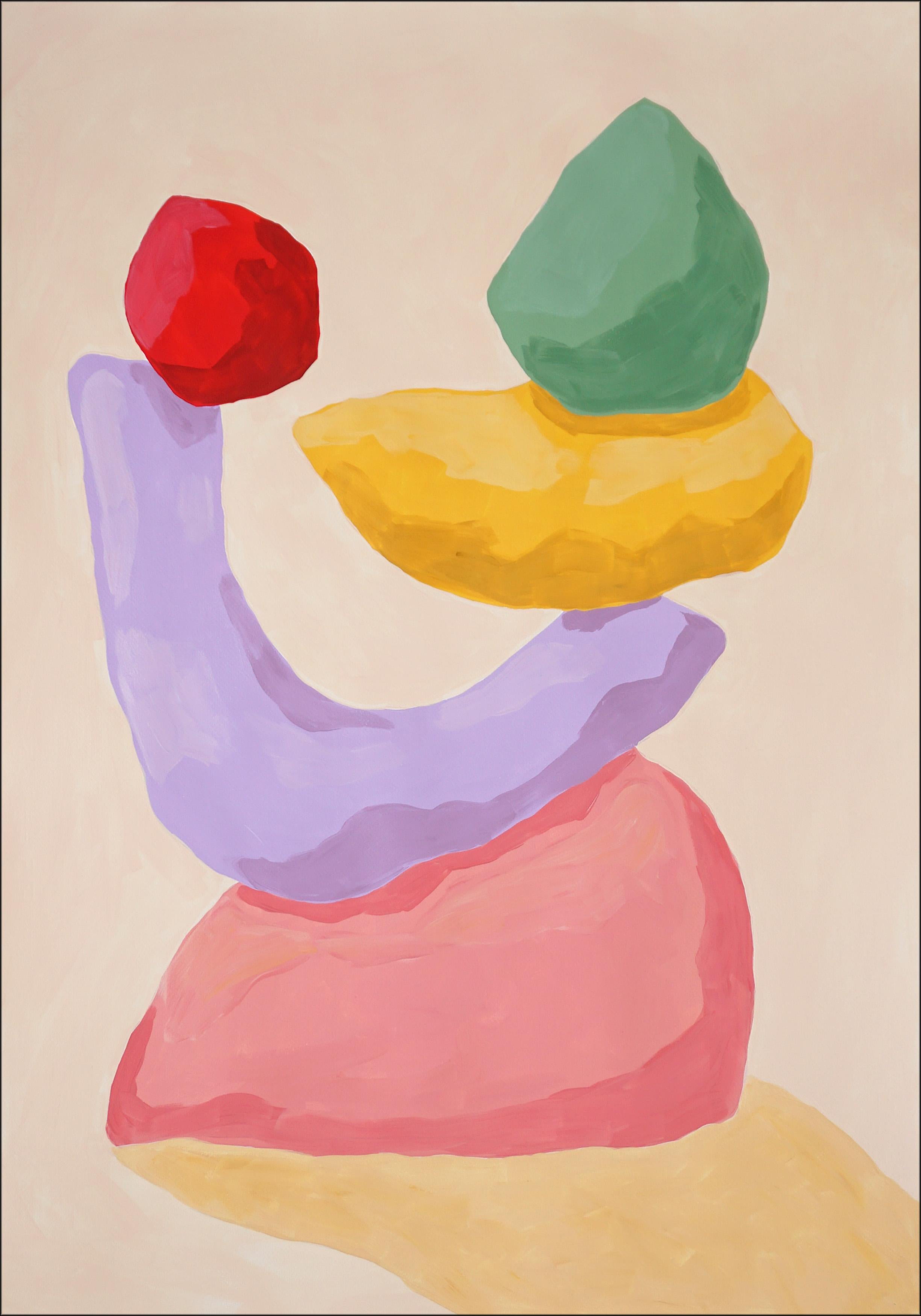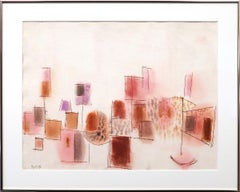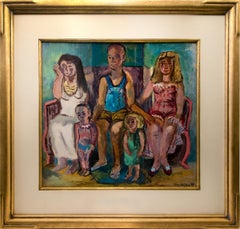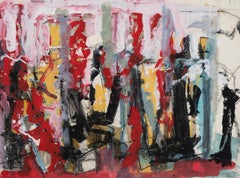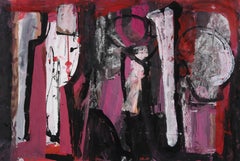
1969 Signed Abstract Watercolor Painting, 'Might', High Street Series
View Similar Items
Want more images or videos?
Request additional images or videos from the seller
1 of 17
William Lumpkins1969 Signed Abstract Watercolor Painting, 'Might', High Street Series1969
1969
About the Item
- Creator:William Lumpkins (1909-2000, American)
- Creation Year:1969
- Dimensions:Height: 16.75 in (42.55 cm)Width: 29.5 in (74.93 cm)Depth: 0.75 in (1.91 cm)
- Medium:
- Movement & Style:
- Period:
- Framing:Frame IncludedFraming Options Available
- Condition:very good condition.
- Gallery Location:Denver, CO
- Reference Number:Seller: 266131stDibs: LU27311364552
About the Seller
5.0
Platinum Seller
These expertly vetted sellers are 1stDibs' most experienced sellers and are rated highest by our customers.
Established in 1979
1stDibs seller since 2013
265 sales on 1stDibs
Typical response time: 3 hours
More From This SellerView All
- 20th Century Framed and Signed Abstract Watercolor Painting, Orange, Pink, RedLocated in Denver, COPink, orange, and red abstract watercolor on paper by Lynn R. Wolfe (1917-2019). Signed by the artist in the lower left corner. Presented in a custom frame with all archival materials measuring 27 ½ x 34 ¼; image size is 22 ¼ x 30 inches. Provenance: Estate of the Artist, Lynn R. Wolfe Painting is in good condition - please contact us for a detailed condition report. About the Artist: Born 1917 Red Cloud, Nebraska Died 2019 Boulder, Colorado A versatile artist proficient in painting, sculpture, stained glass and mosaics, Wolfe grew up on his family’s dairy farm near Red Cloud, Nebraska. For much of his early life he was known as Bob until officially adopting the first name of Lynn in 1939. When he was six months old he contracted the "Spanish flu" in the 1918 influenza pandemic that stunted his growth, making him the smallest student in class. To compensate for his small stature, his family engaged a Black boxer to give him boxing lessons so he could always defend himself against any bullies he encountered at school. Before he started grade school in Red Cloud, one of his grandfathers - a Latin scholar - taught him how to read. His early connection with sculpture occurred when as a youngster he looked for clay in the sandpits near his home to mould figures, including a likeness of his older brother. Similarly, his adult interest in archaeology developed from their search for arrowheads brought to the surface after rainstorms on the family farm. As a teenager he read The Temple Warriors in Chichen Itza, Yucatan, by Earl and Ann Morris with illustrations by Jean Charlot. After World War II Charlot taught fresco painting and worked with Lawrence Barrett on several editions of lithographs at the Colorado Springs Fine Arts Center. In 1947 Wolfe served as Charlot’s chauffeur when he came up to lecture at the University of Colorado in Boulder (CU), and in appreciation received one of the artist’s etchings personally inscribed to him. Following graduation as valedictorian of his high school class, Wolfe enrolled in 1935 as an undergraduate on scholarship at the University of Nebraska at Lincoln, earning his B.A. degree in fine art in 1940. He studied art with Frederick Dwight Kirsch (himself a student of fellow Nebraska native Robert Henri at the Art Students League in New York) who served as Chairman of the Art Department and Director of the University Art Galleries – now the Sheldon Museum - until 1950 when he became director of the Des Moines Art Center. In Nebraska Wolfe painted representational scenes of local buildings such as grain elevators in a landscape setting and small-town street scenes with automobiles. It took Wolfe five years to earn his undergraduate degree because he worked while going to school. In his final year he worked to pay the taxes on the family farm to avoid foreclosure during the Great Depression. While at the University, he prepared fossils and did low relief sculptures of prehistoric animals for the Nebraska State Museum located in Morrill Hall on campus. He also participated in Pleistocene fossil digs in Nebraska and Texas. One of his first jobs after graduation was supervising fossil preparation in Lincoln by twenty-nine workers employed in a Depression-era project sponsored by the federal government. In 1939 he met his future wife Arlene at a sock hop at the University of Nebraska. His first impression of her was a "stunning blond across the room" with whom he shared an interest in the arts and travel. During World War II when she was living and working in Omaha, he proposed to her from New Guinea where he was stationed in the South Pacific. He said that he would take her to Florida if she married him. He later took her and their family on a number of trips to most of Europe, and to Morocco, Algeria, Turkey, China, Japan and Fiji. During the last year of the war he taught photo intelligence in Orlando, Florida, while stationed at the local Air Force base. Prior to the Japanese attack on Pearl Harbor and America’s entry into the war, he worked in the Engineer Corps doing color, texture and illusion. During the war he spent four years in the military, shipping out as a buck private and later advancing to the rank of captain. His classroom experience in Florida helped transition him at war’s end to the University of Nebraska where he taught art for two semesters to fellow intelligence officers studying there on the G.I. Bill. In the summer of 1946 he also was a visiting artist at the University of Alaska where he taught watercolor. In 1947 he relocated to CU in Boulder for his Master of Fine Arts degree on the G.I. Bill. As part of his application earning him a graduate fellowship, he included a photograph of his wife and himself in his captain’s uniform. He took painting and sculpture courses with Muriel Sibell Wolle...Category
Late 20th Century Abstract Abstract Drawings and Watercolors
MaterialsWatercolor, Archival Paper
- 1945 Abstract Landscape with Waterfall Watercolor Painting, Modernist LandscapeBy Eve DreweloweLocated in Denver, COWatercolor on paper painting by Eve (Van Ek) Drewelowe titled "The Champagne Cascades, Crescendos, Crashes" from 1945. An abstract landscape scene of a waterfall with white, yellow, and black. Presented in a custom gold frame, outer dimensions measure 43 ¾ x 33 ¾ x ½ inches. Image size is 29 ¾ x 19 ¾ inches. Painting is clean and in very good vintage condition - please contact us for a detailed condition report. Provenance: Private collection, Denver, Colorado Expedited and international shipping is available - please contact us for a quote. About the Artist: A painter and sculptor, Eve Drewelowe was the eighth of twelve children and grew up on a farm with a tomboyish spirit. Her farm duties did not permit her to take art classes in her youth that she later felt would have hindered the development of her artistic style. Although her father died when she was eleven, he imparted to her reverence for nature and a true love of the earth, values later reflected in her western oil and watercolor landscapes. She attended the University of Iowa at Iowa City on scholarship, receiving her B.A. degree in graphic and plastic arts in 1923. After graduation and against the advice of her art professor, Charles Atherton Cumming who believed that matrimony ended a woman’s painting career, she married fellow student Jacob Van Ek. While he pursued his doctorate in political science, she enrolled in graduate school at the University of Iowa for her M.A. degree in painting and the history of art. At that time her alma mater was one of the few universities in the United States offering an advanced fine arts degree, and she was its first graduate, receiving her degree in 1924. That year the Van Eks moved to Boulder, Colorado, where Jacob had obtained a position as an assistant professor at the University of Colorado. Five years later he became the Dean of the College of Arts & Sciences, a position he held until 1959. Eve briefly studied at the University. In 1927 and 1928 she taught part-time at the University’s School of Engineering and a decade later summer courses (1936 and 1937) in the University’s Department of Fine Arts. In 1926 she became a charter member of the Boulder Artists Guild and participated in its inaugural exhibition. Like many American artists of her generation, she helped foster an art tradition outside the established cultural centers in the East and Midwest. Her professional career spanning six decades largely was spent in and around Boulder. There she produced more than 1,000 works of art in oil, watercolor, pen and ink, and other media in styles of impressionism, regionalism, and abstraction. She devoted a considerable part of her work to Colorado, Wyoming, and Arizona subject matter depicting colorful and fantastic landscapes pulsating with energy and untouched by humans. Excited by what she saw, the wide open spaces made her feel like a modern-day pioneer. In discussing her work, she once said, “What really motivated me in my youth, in my growth, in maturity was my desire to captivate everything. I put on canvas an eagerness to possess the wonder of nature and beauty of color and line – to encompass everything, not to let anything escape.” Before World War II she and her husband took two international trips that had far-reaching consequences for her career, exposing her to the arts and cultures of countries in Asia and Europe. The first in 1928-29 was an extensive excursion in the Far East for which her husband had received a scholarship to study and report on the socioeconomics of Japan, Korea, China, the Philippines, the Dutch East Indies and India. The year after their return she had her first solo show at the University of Colorado’s library gallery. Discussing the twenty-six oils and sixteen ink drawings on view representing sixteen different countries, the Christian Science Monitor reviewer noted: “The pictures have a wide range and are far from being stereotyped in subject matter, being personal in choice. The ink-brush drawings are spontaneous, well balanced, and striking in their masses, giving the sense of having been done on the spot.” Her second trip with her husband and a party from the Bureau of University Travel had a four-month itinerary that included England, Denmark, Finland, Russia, Turkey, Greece, Italy, and France. It yielded seventeen oils and twenty-six ink-wash drawings which she exhibited in a February 1936 solo show at the Boulder Art Association Gallery. Her creative output in the 1930s attracted the attention of the critic for the Parisian Revue des Arts whose observations were translated and printed in the Boulder Daily Camera on June 10, 1937: To present our readers Eve Van Ek [at that time she signed her work with her married name] …is to give them an opportunity to admire a talent of multiple aspects. The eclecticism of her art passes from a rich skill in forceful oil painting of fine strokes of precision best seen perhaps in her treatment of mountain subjects, of craggy cliffs hewn as in nature, through pen and ink or lithographic crayon design, water color, and occasionally embroidery and sculpture, to the delicate perfection of detail of the miniature. The lofty mountains of Colorado have supplied her with extremely interesting subjects for study; she knows how to represent in an entirely personal way the varying scenes and the curious restlessness of the terrain. While pursuing her art, she also was a dean’s wife. The responsibilities attached to that position proved too restrictive, contributing to a grave illness. She underwent an operation in 1940 at the Mayo Clinic for a gastric polyp, a dangerous procedure at that time. Although she had expected to come back to Boulder “in a box,” the surgery proved successful. Depicting her painful hospital stay in a watercolor, Reincarnation, she reflected on the transformative experience of piecing her life back together. That October she received encouragement from the review of her solo exhibition at the Argent Gallery in New York written by Howard Devree, art critic for the New York Times who said: “The whole exhibition is stimulating…Boats, fences and even flowers in the canvases of Eve Van Ek…seem struggling endlessly to escape from the confines of the frame.” Her watercolor, Crosses, Central City (1940), illustrates her work described in the New York review. The composition pulsates with energy conveyed by the modernist technique of juxtaposing the scene’s various angles, distorting the shapes and positions of the structures, additionally highlighting them with bright colors. The telephone poles at various angles represent crosses figuratively marking a Way of the Cross symbolized by the wooden stairs...Category
1940s Abstract Landscape Paintings
MaterialsPaper, Watercolor
- Ortez (Modernist Family Portrait), Abstracted Figural Group of Five, InteriorLocated in Denver, CO"Ortez (Modernist Family Portrait)" is a gouache on paper abstract painting by Lewis Lee Tilley (1921-2005) from 1947 of five family members sitting on a couch. Painted in jewel tone...Category
1940s Abstract Portrait Paintings
MaterialsPaper, Gouache
$2,280 Sale Price20% Off - A Small City Park, Abstract Painting Acrylic Watercolor Painting, Green BrownBy Edward MarecakLocated in Denver, CO"A Small City Park", acrylic and watercolor on paper by Denver artist Edward Marecak (1919-1993) of an abstract park broken into four quadrants, separated by brown and white striped borders with different shaped ponds. Inspired by City Park in Denver, Colorado where the artist frequented. Presented framed with all archival materials, outer dimensions measure 21 ¾ x 18 ¾ inches. Image size measures 12 x 15 inches. Painting is clean and in good condition - please contact us for a detailed condition report. Provenance: Estate of Edward Marecak Expedited and international shipping is available - please contact us for a quote. About the Artist: Born to immigrant parents from the Carpathian region in Slovakia, Marecak grew up with his family in the farming community of Bennett’s Corners, now part of the town of Brunswick, near Cleveland, Ohio. When he turned twelve, his family moved to a multi-ethnic neighborhood of Poles, Czechs, Slovaks and Slovenians in Cleveland. His childhood household cherished the customs and Slavic folk tales from the Old Country that later strongly influenced his work as a professional artist. During junior high he painted scenery for puppet shows of "Peter and the Wolf," awakening his interest in art. In his senior year in high school he did Cézanne-inspired watercolors of Ohio barns at seventy-five cents apiece for the National Youth Administration. They earned him a full scholarship to the Cleveland Institute of Art (1938-1942) where he studied with Henry George Keller whose work was included in the 1913 New York Armory Show. In 1940 Marecak also taught at the Museum School of the Cleveland Institute. Before being drafted into the military in 1942, he briefly attended the Cranbrook Academy of Art near Detroit, one of the nation’s leading graduate schools of art, architecture, and design. A center of innovative work in architecture, art and design with an educational approach built on a mentorship model, it has been home to some of the world’s most renowned designers and artists, including Eero Saarinen, Charles Eames, Daniel Libeskind and Harry Bertoia. Marecak’s studies at Cranbrook with painter Zoltan Sepeshy and sculptor Carl Milles were interrupted by U.S. army service in the Aleutian Islands during World War II. Following his military discharge, Marecak studied on the G.I. Bill at the Colorado Springs Fine Arts Center from 1946 to 1950, having previously met its director, Boardman Robinson, conducting a seminar in mural painting at the Cleveland Institute of Art. Although he did not work with Robinson at the Fine Arts Center, who had become quite ill - retiring in 1947 - he studied Robinson’s specialty of mural painting before leaving to briefly attend the Cranbrook Academy in 1947. That same year he returned to the Fine Arts Center, studying painting with Jean Charlot and Mary Chenoweth, and lithography with Lawrence Barrett with whom he produced some 132 images during 1948-49. At the Fine Arts Center he met his future wife, Donna Fortin, whom he married in 1947. Also a Midwesterner, she had taken night art courses at Hull House in Chicago, later studying at the Art Institute of Chicago with the encouragement of artist Edgar Britton. After World War II she studied with him from 1946 to 1949 at the Fine Arts Center. (He had moved to Colorado Springs to treat his tuberculosis.) Ed Marecak also became good friends with Britton, later collaborating with him on the design of large stained glass windows for a local church. In 1950-51 Marecak returned to the Cleveland Institute of Art to complete his Bachelor of Fine Arts degree. A year later he was invited to conduct a summer class at the University of Colorado in Boulder, confirming his interest in the teaching profession. In 1955 he received his teaching certificate from the University of Denver. Vance Kirkland, the head of its art department, helped him get a teaching job with the Denver Public Schools so that he and his family could remain in the Mile High City. For the next twenty-five years he taught art at Skinner, Grove, East, George Washington and Morey Junior High Schools. Prior to coming to Colorado, Marecak did watercolors resembling those of Winslow Homer, John Singer Sargent and Charles Burchfield. However, once in Colorado Springs he decided to destroy much of his earlier ouevre, embarking on a totally new direction unlike anything he had previously done. Initially, in the 1940s he was influenced by surrealist imagery and Paul Klee, and in the West by Indian petroglyphs and Kachinas. His first one-person show at the Garrett Gallery in Colorado Springs in 1949 featured paintings and lithographs rendered in the style of Magic Realism and referential abstraction. The pieces, including an oil Witch with Pink Dish, foreshadowed the output of his entire Colorado-based career, distinguished by a dramatic use of color, intricacy of execution and attention to detail contributing to their visual impact. He once observed, "Each time I start a new painting I always fool myself by saying this time keep it simple and not get entangled with such complex patterns, color and design; but I always find myself getting more involved with richness, color and subject matter." An idiosyncratic artist proficient in oil, acrylic, watercolor, gouache and casein, he did not draw upon Colorado subject matter for his work, unlike many of his fellow painters in the state. Instead he used Midwest landscape imagery, bringing to life in it witches and spirits adapted from the Slovakian folk tales he heard growing up in Ohio. A number of his paintings depict winter witches derived from the Slovak custom in the Tatra Mountains of burning an effigy of the winter witch in the early spring to banish the memory of a hard winter. The folk tale element imparts a dream-like quality to many of his paintings. A devote of Greek mythology, he placed the figures of Circe, Persephone, Sybil, Hera and others in modern settings. The goddess in Persephone Brings a Pumpkin to her Mother, attired as a Midwestern farmer’s daughter, heralds the advent of fall with the pumpkin before departing to spend the winter season in the underworld. Train to Olympus, the meeting place of the gods in ancient Greece, juxtaposes ancient mythology with modernity creating a combination of whimsy and thought-provoking consideration for the viewer. Voyage to Troy #1 alludes to the ancient city that was the site of the Trojan Wars, but has a contemporary, autobiographical component referencing the harbor of the Aleutian Islands recaptured from the Japanese during World War II. In the 1980s Marecak used the goddess Hera in his painting, Hera Contemplates Aspects of the Art Nouveau, to comment on art movements in the latter half of the twentieth century Marecak’s love of classical music and opera, which he shared with his wife and to which he often listened while painting in his Denver basement studio, is reflected in Homage of Offenbach, an abstract work translating the composer’s musical colors into colorful palette. Pace, Pace, Mio Dio, the title of his earliest surrealist painting, is a soprano aria from Verdi’s opera, La Forza del Destino (The Force of Destiny or Fate, a favorite Marecak subject). His Queen of the Night relates to a character from Mozart’s opera, The Magic Flute. In addition to paintings and works on paper, he produced hooked rugs, textiles and ceramics. He likewise produced designs for ceramics, tableware and furniture created by his wife Donna, an accomplished Colorado ceramist. Both of them generally eschewed exhibitions and galleries, preferring to quietly do their work while remaining outside of the mainstream. He initially exhibited at the Colorado Springs Fine Arts Center in 1948 receiving a purchase award. The following year he had his first one-person show of paintings and lithographs at the Garrett Gallery in Colorado Springs. In the 1950s and early 1960s he participated in group exhibitions at the Print Club (Philadelphia); Amarillo Public Library (Texas); annual Blossom Festival Show (Canon City, Colorado); Adele Simpson’s "Art of Living" in New York; Denver Art Museum; and the Fox Rubenstein-Serkey Gallery (Denver); but he did not have another one-person show until 1966 at the Denver home of his friends, John and Gerda Scott. They arranged for his first one-person show outside of Colorado held two years later at the Martin Lowitz Gallery in Beverly Hills and Palm Springs, California. That same year his work was featured at the Zantman Galleries in Carmel, California. Thereafter he became an infrequent exhibitor after the 1970s so that his work was rarely seen outside his basement studio. In 1980 he, his wife and Mark Zamantakis exhibited at Denver’s Jewish Community Center, and four years later he had a one-person show at the Studio Gallery in Denver. In 1992 he was included in a group show at the Rule Modern and Contemporary Gallery in Denver, and a year later received a large, posthumous retrospective at the Emmanuel...Category
Mid-20th Century Abstract Abstract Paintings
MaterialsPaper, Acrylic, Watercolor
- Winter Palace, 1960s Mid Century Modern Framed Abstract Mixed Media PaintingBy Edward MarecakLocated in Denver, COWinter Palace is an abstract acrylic and watercolor on paper painting by Edward Marecak (1919-1993) with pastel pinks, blues and greens. Presented in a new custom frame, outer dimensions measure 19 ¾ x 23 x 1 inches. Image size is 11 ⅝ x 14 ⅝ inches. Painting is clean and in very good vintage condition - please contact us for a detailed condition report. Provenance: Estate of Edward Marecak Expedited and international shipping is available - please contact us for a quote. About the Artist: Born to immigrant parents from the Carpathian region in Slovakia, Marecak grew up with his family in the farming community of Bennett’s Corners, now part of the town of Brunswick, near Cleveland, Ohio. When he turned twelve, his family moved to a multi-ethnic neighborhood of Poles, Czechs, Slovaks and Slovenians in Cleveland. His childhood household cherished the customs and Slavic folk tales from the Old Country that later strongly influenced his work as a professional artist. During junior high he painted scenery for puppet shows of "Peter and the Wolf...Category
1960s Abstract Abstract Paintings
MaterialsPaper, Mixed Media, Acrylic, Watercolor
- 1950s Abstract Expressionist Watercolor Composition by Charles BunnellBy Charles Ragland BunnellLocated in Denver, COAbstract expressionist watercolor painting of blue, black, orange, and green signed by Charles Ragland Bunnell (1897-1968). Presented in a custom frame with all archival materials an...Category
1950s Abstract Expressionist Abstract Drawings and Watercolors
MaterialsWatercolor, Paper
You May Also Like
- Disco InfernoLocated in Washington, DCPainting titled "Disco Inferno" by Jeanne Cosimano. Wonderful vibrant gouache on paper and dated 2020. Frame is included. This work was recently featured in a solo show at Gallery 2112...Category
21st Century and Contemporary Abstract Expressionist Abstract Paintings
MaterialsGouache, Archival Paper
- TotemLocated in Washington, DCPainting titled "Totem" and dated 2021 by Jeanne Cosimano. Painting is gouache on paper and framed. The painting was recently included in a solo exhibition at Gallery 2112...Category
2010s Abstract Expressionist Abstract Paintings
MaterialsGouache, Archival Paper
- Indian Contemporary Art by Sumit Mehndiratta - GradisimoBy Sumit MehndirattaLocated in Paris, IDFAcrylic ink and acrylic paint on archival watercolor paper Sumit Mehndiratta is an Indian artist born in 1986 who lives & works in New Delhi, India. He has pursued Master of Science...Category
2010s Abstract Abstract Paintings
MaterialsCanvas, Acrylic, Ink, Watercolor, Archival Paper
- Organic Lilac Flower, Organic Painting Style, Pastel Purple, Abstract BackgroundLocated in Barcelona, ESThis is an exclusive handmade mixed media cyanotype with hand-painted acrylic paint in pastel tones. Details: Title: Lilac Leaf on Water Medium: Mixed Media on Watercolor Paper Size: 100x70 cm Year: 2020 *Frame is for illustrative purposes only, artwork is shipped carefully rolled in a tube. WHAT IS A CYANOTYPE? The cyanotype (a.k.a. sun-print) process is one of the oldest in the history of photography, dating back to the 1840's. Cyanotypes were then made famous by Anna Atkins...Category
2010s Abstract Abstract Paintings
MaterialsArchival Ink, Mixed Media, Oil, Acrylic, Watercolor, Archival Paper
$343 Sale Price25% Off - Pastel Geometric Landscape in Vivid Tones, Yellow and Purple Impressionist FieldBy Natalia RomanLocated in Barcelona, ES"Pastel Geometric Landscape" is an abstract painting by Spanish artist Natalia Roman. It is a beautiful abstract architectural painting of unique blur...Category
2010s Abstract Geometric Abstract Paintings
MaterialsMixed Media, Oil, Acrylic, Watercolor, Archival Paper
- Loose Strokes on Sky Blue, Abstract Gestures Patterns, Acrylic Painting on PaperLocated in Barcelona, ES"Loose Strokes on Sky Blue" is an abstract painting by Spanish artist Natalia Roman. It is a beautiful series of rhythmic brushstrokes combined with subtle tones and unique shapes th...Category
2010s Abstract Abstract Paintings
MaterialsArchival Ink, Mixed Media, Oil, Acrylic, Watercolor, Archival Paper
Recently Viewed
View AllMore Ways To Browse
Vintage 1969 Images
Vintage 1969 Image
Local Sign
About Vintage 1969
1969 About Vintage
Vintage Street Sign Signs
1969 Artwork
New Mexico Abstract
Retro Street Sign
Retro Street Signs
Custom Painting Signed By Artist
Dior 1969
Small Framed Art Series
Dior Street
Quiet Sign
Retro High Dior
16 X 29
Small Size Abstract Painting
